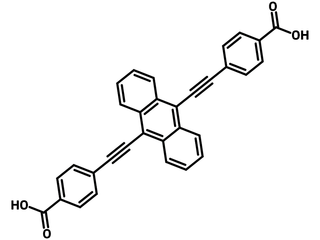4,4'-(Anthracene-9,10-diylbis(ethyne-2,1-diyl))dibenzoic acid
CAS Number 1562777-29-0
Chemistry Building Blocks, Materials, MOF Ligands, Porous Organic FrameworksMetal Organic Frameworks (MOFs) 9,10-Bis(phenylethynyl)anthracene Ligand
A linear ligand linker for MOFs in applications of hydrogen evolution and CO2 reduction reactions.
Specifications | MSDS | Literature and Reviews
4,4'-(Anthracene-9,10-diylbis(ethyne-2,1-diyl))dibenzoic acid, also referred to as H2ABEDB (CAS number 1562777-29-0), is an anthracene derivative with 4-benzoic acids joined linearly at 9,10-poisitons of the central ring of anthracene by two ethynyl groups.
Three-dimensional microporous NNU-27 using 4,4'-(anthracene-9,10-diylbis(ethyne-2,1-diyl))dibenzoic acid ligand shows new charge transport pathway of long-range π-conjugation of ligand in a zig-zag fashion with a high conductivity of 1.3 (±0.5) × 10-3 S/cm. NNU-28, a Zirconium- ABEDB MOF, is highly efficient for visible light driven CO2 reduction with a formate formation rate of 183.3 μmol h−1 mmol MOF−1. Anthracene-based ligand serves as an antenna for light harvesting and participates in CO2 reduction reaction by radical formation.
Zr–ABEDB MOF photocatalyst decorated by 1.0 wt% amount of Pt cocatalyst exhibited a hydrogen evolution rate as high as 704 μmol·h−1·g−1, ca. 220 times of that of pristine Zr–ABEDB MOF (3.2 μmol· h−1·g−1).
General Information
| CAS Number | 1562777-29-0 |
| Chemical Formula | C32H18O4 |
| Full Name | 4,4'-(Anthracene-9,10-diylbis(ethyne-2,1-diyl))dibenzoic acid |
| Molecular Weight | 466.48 g/mol |
| Synonyms | H2ABEDB, ADBEB, 4,4'-(Diethynylanthracene-9,10-diyl)dibenzoic acid, 4,4'-(9,10-Anthracenediyldi-2,1-ethynediyl)bis-benzoic acid |
| Classification / Family | Diethynylanthracene, MOF ligands, |
Chemical Structure

Product Details
| Purity | >98% |
| Melting Point | n.a. |
| Appearance | Orange powder/crystal |
MSDS Documentation
4,4'-(Anthracene-9,10-diylbis(ethyne-2,1-diyl))dibenzoic acid MSDS Sheet
Literature and Reviews
-
Effect of Pt cocatalyst on visible light driven hydrogen evolution of anthracene-based zirconium metal-organic framework, H. Xing et al., Appl. Surf. Sci., 532 (1), 147000 (2020); DOI: 10.1016/j.apsusc.2020.147000.
-
Highly efficient visible-light-driven CO2 reduction to formate by a new anthracene-based zirconium MOF via dual catalytic routes, D. Chen et al., J. Mater. Chem. A, 4, 2657-2662 (2016); DOI: 10.1039/C6TA00429F.
-
Electrical conductivity and electroluminescence of a new anthracene-based metal–organic framework with π-conjugated zigzag chains, D. Chen et al., Chem. Commun., 52, 2019-2022 (2016); DOI: 10.1039/C5CC09065B.
